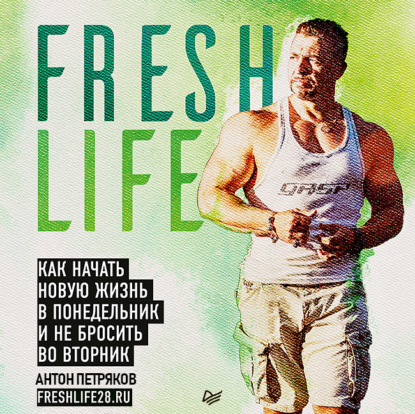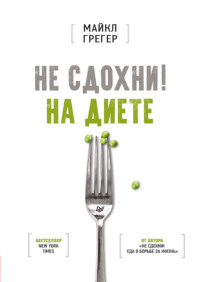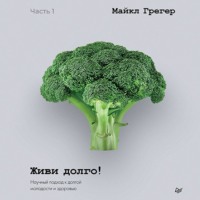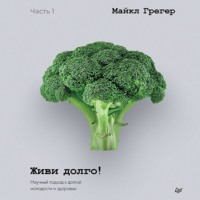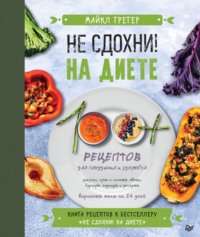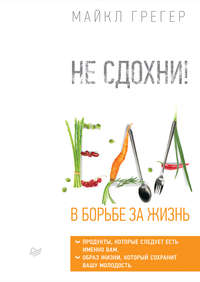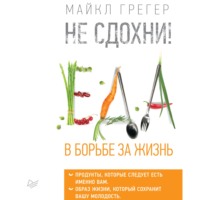
Полная версия
Живи долго! Научный подход к долгой молодости и здоровью
478
Pietrocola F, Castoldi F, Kepp O, Carmona-Gutierrez D, Madeo F, Kroemer G. Spermidine reduces cancer-related mortality in humans. Autophagy. 2019;15(2):362–5. https://pubmed.ncbi.nlm.nih.gov/30354939/
479
Chavez-Dominguez R, Perez-Medina M, Lopez-Gonzalez JS, Galicia-Velasco M, Aguilar-Cazares D. The double-edge sword of autophagy in cancer: from tumor suppression to pro-tumor activity. Front Oncol. 2020;10. https://pubmed.ncbi.nlm.nih.gov/33117715/
480
Madeo F, Eisenberg T, Pietrocola F, Kroemer G. Spermidine in health and disease. Science. 2018;359(6374):eaan2788. https://pubmed.ncbi.nlm.nih.gov/29371440/
481
Madeo F, Eisenberg T, Pietrocola F, Kroemer G. Spermidine in health and disease. Science. 2018;359(6374):eaan2788. https://pubmed.ncbi.nlm.nih.gov/29371440/
482
Barardo D, Thornton D, Thoppil H, et al. The DrugAge database of aging-related drugs. Aging Cell. 2017;16(3):594–7. https://pubmed.ncbi.nlm.nih.gov/28299908/
483
DrugAge: database of ageing-related drugs. https://genomics.senescence.info/drugs/stats.php. Updated February 7, 2023. Accessed February 11, 2023.; https://genomics.senescence.info/drugs/stats.php
484
Janssens GE, Houtkooper RH. Identification of longevity compounds with minimized probabilities of side effects. Biogerontology. 2020;21(6):709–19. https://pubmed.ncbi.nlm.nih.gov/32562114/
485
Hunter DC, Burritt DJ. Polyamines of plant origin: an important dietary consideration for human health. In: Rao V, ed. Phytochemicals as Nutraceuticals: Global Approaches to Their Role in Nutrition and Health. InTech; 2012:225–44. https://www.intechopen.com/chapters/32904
486
Larqué E, Sabater-Molina M, Zamora S. Biological significance of dietary polyamines. Nutrition. 2007;23(1):87–95. https://pubmed.ncbi.nlm.nih.gov/17113752/
487
Khandia R, Dadar M, Munjal A, et al. A comprehensive review of autophagy and its various roles in infectious, non-infectious, and lifestyle diseases: current knowledge and prospects for disease prevention, novel drug design, and therapy. Cells. 2019;8(7):674. https://pubmed.ncbi.nlm.nih.gov/31277291/
488
Hayflick L, Moorhead PS. 1961. The serial cultivation of human diploid cell strains. Exp. Cell Res. 25, 585–621.; https://pubmed.ncbi.nlm.nih.gov/13905658/
489
Zhang H, Simon AK. Polyamines reverse immune senescence via the translational control of autophagy. Autophagy. 2020;16(1):181–2. https://pubmed.ncbi.nlm.nih.gov/31679458/
490
Luo J, Si H, Jia Z, Liu D. Dietary anti-aging polyphenols and potential mechanisms. Antioxidants. 2021;10(2):283. https://pubmed.ncbi.nlm.nih.gov/33668479/
491
Schmitt R. Senotherapy: growing old and staying young? Pflugers Arch-Eur J Physiol. 2017;469(9):1051–9. https://pubmed.ncbi.nlm.nih.gov/28389776/
492
van Deursen JM. Senolytic therapies for healthy longevity. Science. 2019;364(6441):636–7. https://pubmed.ncbi.nlm.nih.gov/31097655/
493
Baker DJ, Petersen RC. Cellular senescence in brain aging and neurodegenerative diseases: evidence and perspectives. J Clin Invest. 2018;128(4):1208–16. https://pubmed.ncbi.nlm.nih.gov/29457783/
494
Davan-Wetton CSA, Pessolano E, Perretti M, Montero-Melendez T. Senescence under appraisal: hopes and challenges revisited. Cell Mol Life Sci. 2021;78(7):3333–54. https://pubmed.ncbi.nlm.nih.gov/33439271/
495
Prašnikar E, Borišek J, Perdih A. Senescent cells as promising targets to tackle age-related diseases. Ageing Res Rev. 2021;66:101251. https://pubmed.ncbi.nlm.nih.gov/33385543/
496
Zhu Y, Tchkonia T, Pirtskhalava T, et al. The Achilles’ heel of senescent cells: from transcriptome to senolytic drugs. Aging Cell. 2015;14(4):644–58. https://pubmed.ncbi.nlm.nih.gov/25754370/
497
van Deursen JM. Senolytic therapies for healthy longevity. Science. 2019;364(6441):636–7. https://pubmed.ncbi.nlm.nih.gov/31097655/
498
Mau T, Yung R. Adipose tissue inflammation in aging. Exp Gerontol. 2018;105:27–31. https://pubmed.ncbi.nlm.nih.gov/29054535/
499
Prašnikar E, Borišek J, Perdih A. Senescent cells as promising targets to tackle age-related diseases. Ageing Res Rev. 2021;66:101251. https://pubmed.ncbi.nlm.nih.gov/33385543/
500
de Keizer PLJ. The fountain of youth by targeting senescent cells? Trends Mol Med. 2017;23(1):6–17. https://pubmed.ncbi.nlm.nih.gov/28041565/
501
Prašnikar E, Borišek J, Perdih A. Senescent cells as promising targets to tackle age-related diseases. Ageing Res Rev. 2021;66:101251. https://pubmed.ncbi.nlm.nih.gov/33385543/
502
van Deursen JM. Senolytic therapies for healthy longevity. Science. 2019;364(6441):636–7. https://pubmed.ncbi.nlm.nih.gov/31097655/
503
Hofmann B. Young blood rejuvenates old bodies: a call for reflection when moving from mice to men. Transfus Med Hemother. 2018;45(1):67–71. https://pubmed.ncbi.nlm.nih.gov/29593463/
504
Ludwig FC, Elashoff RM. Mortality in syngeneic rat parabionts of different chronological age. Trans N Y Acad Sci. 1972;34(7):582–7. https://pubmed.ncbi.nlm.nih.gov/4507935/
505
Lavazza A, Garasic M. Vampires 2.0? The ethical quandaries of young blood infusion in the quest for eternal life. Med Health Care Philos. 2020;23(3):421–32. https://pubmed.ncbi.nlm.nih.gov/32447568/
506
Rebo J, Mehdipour M, Gathwala R, et al. A single heterochronic blood exchange reveals rapid inhibition of multiple tissues by old blood. Nat Commun. 2016;7(1):13363. https://pubmed.ncbi.nlm.nih.gov/27874859/
507
Mehdipour M, Skinner C, Wong N, et al. Rejuvenation of three germ layers tissues by exchanging old blood plasma with saline-albumin. Aging (Albany NY). 2020;12(10):8790–819. https://pubmed.ncbi.nlm.nih.gov/32474458/
508
Boada M, López OL, Olazarán J, et al. A randomized, controlled clinical trial of plasma exchange with albumin replacement for Alzheimer’s disease: primary results of the AMBAR Study. Alzheimers Dement. 2020;16(10):1412–25. https://pubmed.ncbi.nlm.nih.gov/32715623/
509
Biller-Andorno N. Young blood for old hands? A recent anti-ageing trial prompts ethical questions. Swiss Med Wkly. 2016;146(3940):w14359. https://pubmed.ncbi.nlm.nih.gov/27684581/
510
Xu M, Pirtskhalava T, Farr JN, et al. Senolytics improve physical function and increase lifespan in old age. Nat Med. 2018;24(8):1246–56. https://www.ncbi.nlm.nih.gov/pmc/articles/PMC6082705/
511
Baker DJ, Childs BG, Durik M, et al. Naturally occurring p16INK4a-positive cells shorten healthy lifespan. Nature. 2016;530(7589):184–9. https://www.ncbi.nlm.nih.gov/pmc/articles/PMC4845101/
512
de Keizer PLJ. The fountain of youth by targeting senescent cells? Trends Mol Med. 2017;23(1):6–17. https://pubmed.ncbi.nlm.nih.gov/28041565/
513
Chen X, Yi Z, Wong GT, et al. Is exercise a senolytic medicine? A systematic review. Aging Cell. 2021;20(1). https://www.ncbi.nlm.nih.gov/pmc/articles/PMC7811843/
514
Fontana L, Mitchell SE, Wang B, et al. The effects of graded caloric restriction: XII. Comparison of mouse to human impact on cellular senescence in the colon. Aging Cell. 2018;17(3):e12746. https://www.ncbi.nlm.nih.gov/pmc/articles/PMC5946078/
515
Rusznyák S, Szent-Györgyi A. Vitamin P: flavonols as vitamins. Nature. 1936;138(3479):27. https://www.nature.com/articles/138027a0
516
Belinha I, Amorim MA, Rodrigues P, et al. Quercetin increases oxidative stress resistance and longevity in Saccharomyces cerevisiae. J Agric Food Chem. 2007;55(6):2446–51. https://pubmed.ncbi.nlm.nih.gov/17323973/
517
Formica JV, Regelson W. Review of the biology of quercetin and related bioflavonoids. Food Chem Toxicol. 1995;33(12):1061–80. https://pubmed.ncbi.nlm.nih.gov/8847003/
518
Kirkland JL, Tchkonia T. Senolytic drugs: from discovery to translation. J Intern Med. 2020;288(5):518–36. https://www.ncbi.nlm.nih.gov/pmc/articles/PMC7405395/
519
Zhu Y, Tchkonia T, Pirtskhalava T, et al. The Achilles’ heel of senescent cells: from transcriptome to senolytic drugs. Aging Cell. 2015;14(4):644–58. https://pubmed.ncbi.nlm.nih.gov/25754370/
520
Geng L, Liu Z, Wang S, et al. Low-dose quercetin positively regulates mouse healthspan. Protein Cell. 2019;10(10):770–5. https://www.ncbi.nlm.nih.gov/pmc/articles/PMC6776572/
521
Yang D, Wang T, Long M, Li P. Quercetin: its main pharmacological activity and potential application in clinical medicine. Oxid Med Cell Longev. 2020;2020:1–13. https://www.ncbi.nlm.nih.gov/pmc/articles/PMC7790550/
522
Murphy MM, Barraj LM, Herman D, Bi X, Cheatham R, Randolph RK. Phytonutrient intake by adults in the United States in relation to fruit and vegetable consumption. J Acad Nutr Diet. 2012;112(2):222–9. https://pubmed.ncbi.nlm.nih.gov/22741166/
523
Mai F, Glomb MA. Isolation of phenolic compounds from iceberg lettuce and impact on enzymatic browning. J Agric Food Chem. 2013;61(11):2868–74. https://pubmed.ncbi.nlm.nih.gov/23473017/
524
Murphy MM, Barraj LM, Herman D, Bi X, Cheatham R, Randolph RK. Phytonutrient intake by adults in the United States in relation to fruit and vegetable consumption. J Acad Nutr Diet. 2012;112(2):222–9. https://pubmed.ncbi.nlm.nih.gov/22741166/
525
Agricultural Research Service, United States Department of Agriculture. Onions, raw. FoodData Central. https://fdc.nal.usda.gov/fdc-app.html?query=onion&utf8=%E2%9C%93&affiliate=usda&commit=Search#/food-details/170000/nutrients. Published April 1, 2019. Accessed May 11, 2021.; https://fdc.nal.usda.gov/fdc-app.html#/food-details/170000/nutrients
526
Agricultural Research Service, United States Department of Agriculture. Onions, red, raw. FoodData Central. https://fdc.nal.usda.gov/fdc-app.html?query=onion&utf8=%E2%9C%93&affiliate=usda&commit=Search#/food-details/790577/nutrients. Published April 1, 2020. Accessed May 11, 2021.; https://fdc.nal.usda.gov/fdc-app.html#/food-details/170000/nutrients
527
Agricultural Research Service, United States Department of Agriculture. Apple, raw. FoodData Central. https://fdc.nal.usda.gov/fdc-app.html?query=apples&utf8=%E2%9C%93&affiliate=usda&commit=Search#/food-details/1102644/nutrients. Published October 30, 2020. Accessed May 11, 2021.; https://fdc.nal.usda.gov/fdc-app.html?query=apples&utf8=%E2%9C%93&affiliate=usda&commit=Search#/food-details/1102644/nutrients
528
Formica JV, Regelson W. Review of the biology of quercetin and related bioflavonoids. Food Chem Toxicol. 1995;33(12):1061–80. https://pubmed.ncbi.nlm.nih.gov/8847003/
529
Amanzadeh E, Esmaeili A, Rahgozar S, Nourbakhshnia M. Application of quercetin in neurological disorders: from nutrition to nanomedicine. Rev Neurosci. 2019;30(5):555–72. https://pubmed.ncbi.nlm.nih.gov/30753166/
530
Vida RG, Fittler A, Somogyi-Végh A, Poór M. Dietary quercetin supplements: assessment of online product informations and quantitation of quercetin in the products by high-performance liquid chromatography. Phytother Res. 2019;33(7):1912–20. https://pubmed.ncbi.nlm.nih.gov/31155780/
531
Harwood M, Danielewska-Nikiel B, Borzelleca JF, Flamm GW, Williams GM, Lines TC. A critical review of the data related to the safety of quercetin and lack of evidence of in vivo toxicity, including lack of genotoxic/carcinogenic properties. Food Chem Toxicol. 2007;45(11):2179–205. https://pubmed.ncbi.nlm.nih.gov/17698276/
532
Hickson LJ, Langhi Prata LGP, Bobart SA, et al. Senolytics decrease senescent cells in humans: preliminary report from a clinical trial of Dasatinib plus Quercetin in individuals with diabetic kidney disease. EBioMedicine. 2019;47:446–56. https://www.ncbi.nlm.nih.gov/pmc/articles/PMC6796530/
533
Briggs ADM, Mizdrak A, Scarborough P. A statin a day keeps the doctor away: comparative proverb assessment modelling study. BMJ. 2013;347:f7267. https://www.bmj.com/content/347/bmj.f7267
534
Bondonno NP, Bondonno CP, Blekkenhorst LC, et al. Flavonoid-rich apple improves endothelial function in individuals at risk for cardiovascular disease: a randomized controlled clinical trial. Mol Nutr Food Res. 2018;62(3). https://pubmed.ncbi.nlm.nih.gov/29086478/
535
Huang H, Liao D, Dong Y, Pu R. Effect of quercetin supplementation on plasma lipid profiles, blood pressure, and glucose levels: a systematic review and meta-analysis. Nutr Rev. 2020;78(8):615–26. https://pubmed.ncbi.nlm.nih.gov/31940027/
536
Tabrizi R, Tamtaji OR, Mirhosseini N, et al. The effects of quercetin supplementation on lipid profiles and inflammatory markers among patients with metabolic syndrome and related disorders: a systematic review and meta-analysis of randomized controlled trials. Crit Rev Food Sci Nutr. 2020;60(11):1855–68. https://pubmed.ncbi.nlm.nih.gov/31017459/
537
Mohammadi-Sartang M, Mazloom Z, Sherafatmanesh S, Ghorbani M, Firoozi D. Effects of supplementation with quercetin on plasma C-reactive protein concentrations: a systematic review and meta-analysis of randomized controlled trials. Eur J Clin Nutr. 2017;71(9):1033–9. https://pubmed.ncbi.nlm.nih.gov/28537580/
538
Nakagawa T, Itoh M, Ohta K, et al. Improvement of memory recall by quercetin in rodent contextual fear conditioning and human early-stage Alzheimer’s disease patients. Neuroreport. 2016;27(9):671–6. https://pubmed.ncbi.nlm.nih.gov/27145228/
539
Nishimura M, Ohkawara T, Nakagawa T, et al. A randomized, double-blind, placebo-controlled study evaluating the effects of quercetin-rich onion on cognitive function in elderly subjects. FFHD. 2017;7(6):353–74. https://ffhdj.com/index.php/ffhd/article/view/334
540
Kalus U, Pindur G, Jung F, et al. Influence of the onion as an essential ingredient of the Mediterranean diet on arterial blood pressure and blood fluidity. Arzneimittelforschung. 2000;50(9):795–801. https://pubmed.ncbi.nlm.nih.gov/11050695/
541
Hertog MG, Feskens EJ, Hollman PC, Katan MB, Kromhout D. Dietary antioxidant flavonoids and risk of coronary heart disease: the Zutphen Elderly Study. Lancet. 1993;342(8878):1007–11. https://pubmed.ncbi.nlm.nih.gov/8105262/
542
Briggs ADM, Mizdrak A, Scarborough P. A statin a day keeps the doctor away: comparative proverb assessment modelling study. BMJ. 2013;347:f7267. https://www.bmj.com/content/347/bmj.f7267
543
Hwang HV, Tran DT, Rebuffatti MN, Li CS, Knowlton AA. Investigation of quercetin and hyperoside as senolytics in adult human endothelial cells. PLoS ONE. 2018;13(1):e0190374. https://www.ncbi.nlm.nih.gov/pmc/articles/PMC5760026/
544
Khan S, Shukla S, Sinha S, Meeran SM. Epigenetic targets in cancer and aging: dietary and therapeutic interventions. Expert Opin Ther Targets. 2016;20(6):689–703. https://pubmed.ncbi.nlm.nih.gov/26667209/
545
Geng L, Liu Z, Zhang W, et al. Chemical screen identifies a geroprotective role of quercetin in premature aging. Protein Cell. 2019;10(6):417–35. https://www.ncbi.nlm.nih.gov/pmc/articles/PMC6538594/
546
Chondrogianni N, Kapeta S, Chinou I, Vassilatou K, Papassideri I, Gonos ES. Anti-ageing and rejuvenating effects of quercetin. Exp Gerontol. 2010;45(10):763–71. https://pubmed.ncbi.nlm.nih.gov/20619334/
547
Zhu Y, Doornebal EJ, Pirtskhalava T, et al. New agents that target senescent cells: the flavone, fisetin, and the BCL–XL inhibitors, A1331852 and A1155463. Aging (Albany NY). 2017;9(3):955–63. https://www.ncbi.nlm.nih.gov/pmc/articles/PMC5391241/
548
Wyld L, Bellantuono I, Tchkonia T, et al. Senescence and cancer: a review of clinical implications of senescence and senotherapies. Cancers (Basel). 2020;12(8):2134. https://www.ncbi.nlm.nih.gov/pmc/articles/PMC7464619/
549
Li W, Qin L, Feng R, et al. Emerging senolytic agents derived from natural products. Mech Ageing Dev. 2019;181:1–6. https://pubmed.ncbi.nlm.nih.gov/31077707/
550
Yousefzadeh MJ, Zhu Y, McGowan SJ, et al. Fisetin is a senotherapeutic that extends health and lifespan. EBioMedicine. 2018;36:18–28. https://www.ncbi.nlm.nih.gov/pmc/articles/PMC6197652/
551
Maher P, Akaishi T, Abe K. Flavonoid fisetin promotes ERK-dependent long-term potentiation and enhances memory. PNAS. 2006;103(44):16568–73. https://www.ncbi.nlm.nih.gov/pmc/articles/PMC1637622/
552
Farsad-Naeimi A, Alizadeh M, Esfahani A, Darvish Aminabad E. Effect of fisetin supplementation on inflammatory factors and matrix metalloproteinase enzymes in colorectal cancer patients. Food Funct. 2018;9(4):2025–31. https://pubmed.ncbi.nlm.nih.gov/29541713/
553
Yousefzadeh MJ, Zhu Y, McGowan SJ, et al. Fisetin is a senotherapeutic that extends health and lifespan. EBioMedicine. 2018;36:18–28. https://www.ncbi.nlm.nih.gov/pmc/articles/PMC6197652/
554
U.S. National Library of Medicine. Search results for fisetin. ClinicalTrials.gov. https://clinicaltrials.gov/ct2/results?cond=&term=fisetin&cntry=&state=&city=&dist=. Accessed May 29, 2021.; https://clinicaltrials.gov/ct2/results?cond=&term=fisetin&cntry=&state=&city=&dist=
555
Grynkiewicz G, Demchuk OM. New perspectives for fisetin. Front Chem. 2019;7:697. https://pubmed.ncbi.nlm.nih.gov/31750288/
556
Rabin BM, Joseph JA, Shukitt-Hale B. Effects of age and diet on the heavy particle-induced disruption of operant responding produced by a ground-based model for exposure to cosmic rays. Brain Res. 2005;1036(1–2):122–9. https://pubmed.ncbi.nlm.nih.gov/15725409/
557
Miller MG, Thangthaeng N, Rutledge GA, Scott TM, Shukitt-Hale B. Dietary strawberry improves cognition in a randomised, double-blind, placebo-controlled trial in older adults. Br J Nutr. Published online January 20, 2021:1–11.; https://pubmed.ncbi.nlm.nih.gov/33468271/
558
Gao Q, Qin LQ, Arafa A, Eshak ES, Dong JY. Effects of strawberry intervention on cardiovascular risk factors: a meta-analysis of randomised controlled trials. Br J Nutr. 2020;124(3):241–6. https://pubmed.ncbi.nlm.nih.gov/32238201/
559
Schell J, Scofield RH, Barrett JR, et al. Strawberries improve pain and inflammation in obese adults with radiographic evidence of knee osteoarthritis. Nutrients. 2017;9(9):949. https://www.ncbi.nlm.nih.gov/pmc/articles/PMC5622709/
560
Ezzat-Zadeh Z, Henning SM, Yang J, et al. California strawberry consumption increased the abundance of gut microorganisms related to lean body weight, health and longevity in healthy subjects. Nutr Res. 2021;85:60–70. https://pubmed.ncbi.nlm.nih.gov/33450667/
561
Morotomi M, Nagai F, Watanabe Y. Description of Christensenella minuta gen. nov., sp. nov., isolated from human faeces, which forms a distinct branch in the order Clostridiales, and proposal of Christensenellaceae fam. nov. Int J Syst Evol. 2012;62(1):144–9. https://pubmed.ncbi.nlm.nih.gov/21357455/
562
Waters JL, Ley RE. The human gut bacteria Christensenellaceae are widespread, heritable, and associated with health. BMC Biol. 2019;17(1):83. https://www.ncbi.nlm.nih.gov/pmc/articles/PMC6819567/
563
Wang Y, Chang J, Liu X, et al. Discovery of piperlongumine as a potential novel lead for the development of senolytic agents. Aging (Albany NY). 2016;8(11):2915–26. https://www.ncbi.nlm.nih.gov/pmc/articles/PMC5191878/
564
Yadav V, Krishnan A, Vohora D. A systematic review on Piper longum L.: bridging traditional knowledge and pharmacological evidence for future translational research. J Ethnopharmacol. 2020;247:112255. https://pubmed.ncbi.nlm.nih.gov/31568819/
565
Kumar S, Kamboj J, Suman, Sharma S. Overview for various aspects of the health benefits of Piper Longum Linn. fruit. J Acupunct Meridian Stud. 2011;4(2):134–40. https://pubmed.ncbi.nlm.nih.gov/21704957/
566
López-Otín C, Blasco MA, Partridge L, Serrano M, Kroemer G. The hallmarks of aging. Cell. 2013;153(6):1194–217. https://pubmed.ncbi.nlm.nih.gov/23746838/
567
van Deursen JM. Senolytic therapies for healthy longevity. Science. 2019;364(6441):636–7. https://pubmed.ncbi.nlm.nih.gov/31097655/
568
López-León M, Goya RG. The emerging view of aging as a reversible epigenetic process. Gerontology. 2017;63(5):426–31. https://pubmed.ncbi.nlm.nih.gov/28538216/
569
Sallon S, Solowey E, Cohen Y, et al. Germination, genetics, and growth of an ancient date seed. Science. 2008;320(5882):1464. https://pubmed.ncbi.nlm.nih.gov/18556553/
570
Yashina S, Gubin S, Maksimovich S, Yashina A, Gakhova E, Gilichinsky D. Regeneration of whole fertile plants from 30,000-y-old fruit tissue buried in Siberian permafrost. Proc Natl Acad Sci U S A. 2012;109(10):4008–13. https://www.ncbi.nlm.nih.gov/pmc/articles/PMC3309767/
571
Rando TA, Chang HY. Aging, rejuvenation, and epigenetic reprogramming: resetting the aging clock. Cell. 2012;148(1–2):46–57. https://pubmed.ncbi.nlm.nih.gov/22265401/
572
Rando TA, Chang HY. Aging, rejuvenation, and epigenetic reprogramming: resetting the aging clock. Cell. 2012;148(1–2):46–57. https://pubmed.ncbi.nlm.nih.gov/22265401/
573
Американская кантри-певица и киноактриса. – Примеч. ред.
574
BBC News. 1997: Dolly the sheep is cloned. On this day: 1950–2005. BBC. http://news.bbc.co.uk/onthisday/hi/dates/stories/february/22/newsid_4245000/4245877.stm. Published February 22, 2005. Accessed May 26, 2021.; https://news.bbc.co.uk/onthisday/hi/dates/stories/february/22/newsid_4245000/4245877.stm
575
Gurdon JB. The cloning of a frog. Development. 2013;140(12):2446–8. https://pubmed.ncbi.nlm.nih.gov/23715536/
576
Burgstaller JP, Brem G. Aging of cloned animals: a mini-review. Gerontology. 2017;63(5):417–25. https://pubmed.ncbi.nlm.nih.gov/27820924/
577
López-León M, Goya RG. The emerging view of aging as a reversible epigenetic process. Gerontology. 2017;63(5):426–31. https://pubmed.ncbi.nlm.nih.gov/28538216/





